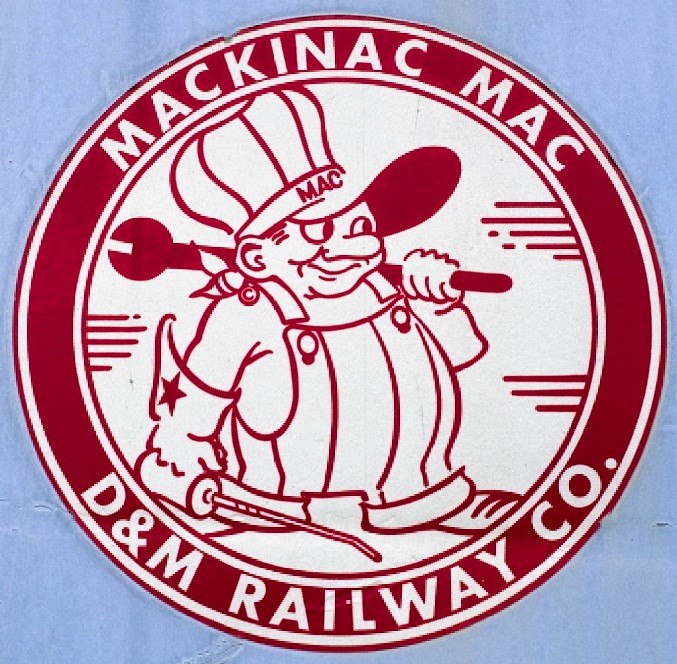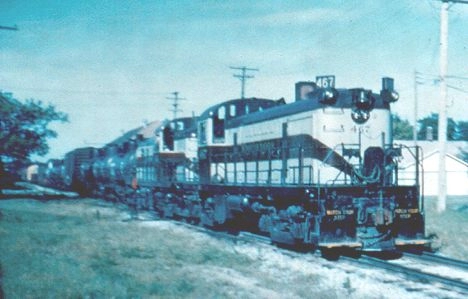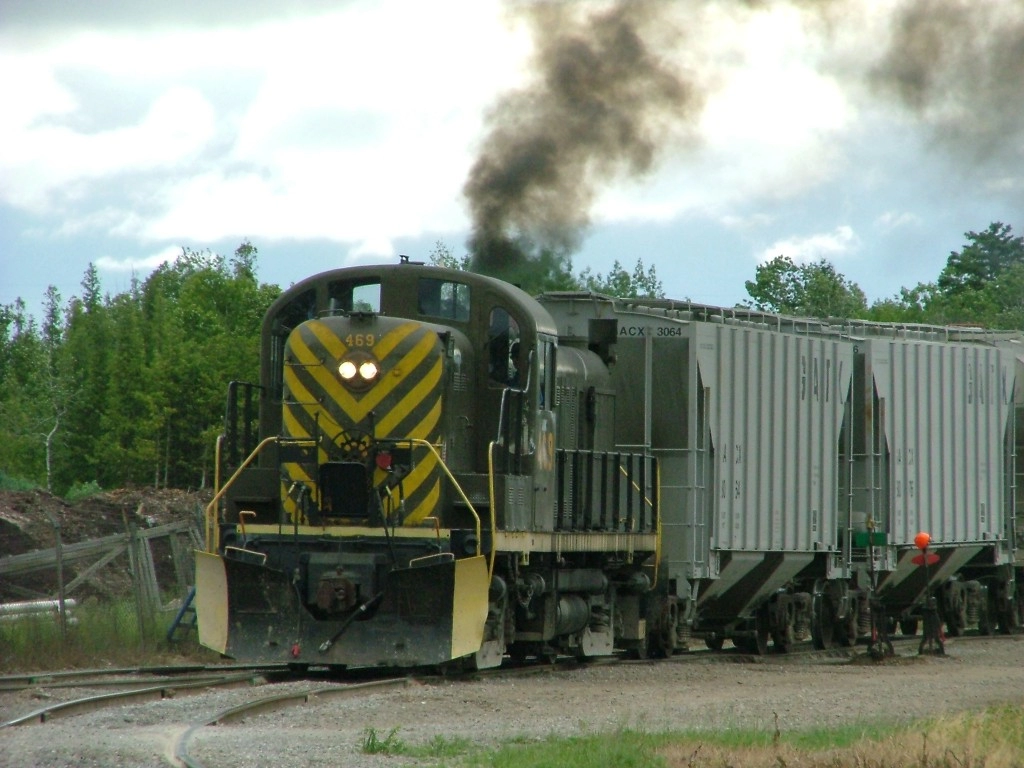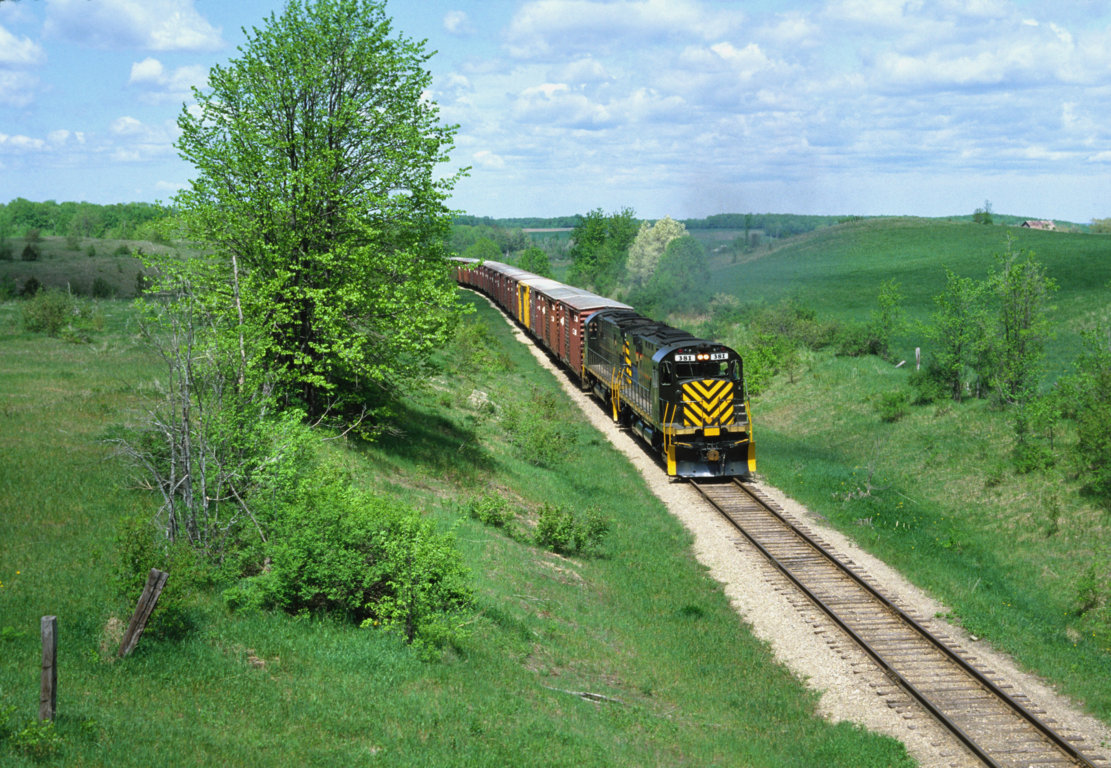- Details
- Hits: 3983
Railroad: Detroit and Mackinac Railway Company
The Detroit & Mackinac railway was assembled by New York railroad financers associated with J. P. Morgan & Co. in 1895 by combining the Detroit, Bay City & Alpena and the Alpena & Northern railroads. The Au Sable & Northwestern was added about 1912. The railroad continued operation for many years.
The D&M was one of the first railroads to fully dieselize in 1946 with a fleet of Alco road switchers.

DBC&A and A&N → Detroit & Mackinac Railway → Lake State Railway
Acquired: 1894 from Alger to Alpena. Alpena to Cheboygan.
Became: Lake State Ry in 1992. [LSRC website].
Reference: [MRRC]



Notes
Passenger service was discontinued in 1950. In 1976, the railroad purchased portions of the old Michigan Central Mackinaw Division and operated other sections under state ownership. In 1989, the line north of Alpena was abandoned. The line was sold to the Lake State Railway in 1992.
Acquired the Detroit, Bay City & Alpena Railroad in 1894. Bought Alpena Northern Ry. in 1895, Leased Au Sable & Northwestern in 1912 and purchased it in 1914. Purchased former Penn Central line in Kawkawlin to Pinconning and Sallings (near Lake Otsego) to Mackinaw City in 1976. Also operated state-owned portion from Pinconning to Sallings at this time.
Photo Info: D&M 467 and 466 pull a freight through Tawas City in the 1960's. [Harold Frye]. 2nd photo, D&M 469 works at Alpena Junction Yard. 3rd photo, D&M 181 and 381 head southbound into Gaylord from Cheboygan in 1984. [Neil Plagens]
Time Line
1895. September 5. The new extension of the Detroit & Mackinac road to Bay City has become a sure thing. A staff of men headed by Chief Engineer Wenzell have commenced putting in the grade stakes from Emery Junction. The road has secured the right-of-way through Iosco and Arenac counties. They will commence grading this fall and it is expected that the extension will be in operation by fall of 1896. [DFP-1895-0906]
1896. September 6. Vice President and General Manager J. D. Hawks of the Detroit & Mackinac Railway announces that the extension from Emery Junction to Bay City will be opened for traffic on Sunday, September 20, at noon. The connection of the road with the Michigan Central at Alger will be discontinued on the same day. All freight and passenger business for Tobico, Linwood, Pinconning, Saganing, Pine River, Omer and Turner on the new line and all points on the old system, except Alger, Moffat and Shearer, which will be abandoned by the company will be done via Bay City. [DFP-1896-0906]
1896. September 26. The ballasting crew on the Detroit & Mackinac has passed Pinconning on the way down with the second lift. Monday the engineer will lay out two miles of side tracks a the north end of the bridge over Saginaw river. As soon as the men finish with the new work they will be sent to take up the track from Alger to Prescott. The rails will be used for extending some of the branches into the pineries. [DFP-1896-0927]
1898. February. Heavy snow stalls railroad trains on the D&M. They have not run a train for the last four days north from Bay City. A snow plow derailed at Lengsville injuring four employees. [DFP-1898-0222]
1898. In 1891, an act was passed exempting railroads to be constructed north of parallel 44 of latitude from taxes for ten years. Under this act as of 1898, the Alpena and Northern division of the D&M, having 84.7 miles of road, have been paying no taxes whatever. [DFP-1898-0323]
1901. Harrisville. April 25. Supt. Luce and Engineer Waterman of the D&M railway were here Wednesday, and at a public meeting agreed to change their route and extend the roadbed here provided a right of way is given through the county, a distance of about 27 miles. [PHDH-1901-0425]
1901. Detroit newspapermen are provided with a special train trip between Detroit and Tower (west of Onaway in Cheboygan County) the end of the line in 1901. The trip was called the "Gillman Special", named after a railroad official, and ran from Detroit, through Saginaw and Bay City, Alpena to Tower and return. The purpose of the trip was to show off the Pere Marquette and Detroit & Mackinac railroads and their passenger trains. Present on the trip were representatives of the PM and D&M, the Bay City Times, Detroit Evening News, Flint Globe, Saginaw Courier-Herald and Bay City Tribune. The group left Detroit in the private car of PM superintendent Agnew. The first stop was in Northville, called the "Switzerland of Wayne County", then Saginaw and Plymouth. At Bay City, the private car of D&M General Superintendent C.W. Luce was added. [DFP-1901-1027]
1902. The D&M passes into control of Henry K. McHarg, who is a director of the Wabash railroad and president of several southern railroads. It is believed that this transfer means that the D&M will become a part of the reorganized Wabash System. [PHTH-1902-0524]. Editor's Note: The D&M remained an independent road.
1902. The general offices of the D&IM will be moved tomorrow to the fifth floor of the Majestic building in Detroit. [DFP-1902-0330]. Note: The railroad annual meetings were held annually in Alpena.
1903. SNAPSHOT: The D&M had 30 engineers, 33 fireman, 22 conductors, 39 brakemen, 8 baggage men, 151 laborers (mostly on section crews on 46 sections), 113 shopmen and 27 yardmen. The railroad installed 105,000 ties in 1903. The railroad has 28 locomotives. Top five commodities hauled in 1903 were logs (52%), coal (15%), lumber (9%), merchandise (6%) and stone (5%). [MCR-1904]
1906. SNAPSHOT: The D&M runs from Bay City north along the west shore of Lake Huron and then northwest to Cheboygan, 195 miles. There are 143 miles of short branches, most of which were built to open up timberlands. Most of the traffic is in timber; of the 1.1 million tons of freight carried in 1906, 11 percent was lumber and 42% forest products other than lumber, that is to say, unsawed logs and pulpwood. A great proportion of the timber is hardwood, since Presque Isle county northwest the D&M taps the hard wood strip which runs north and south through most of the lower peninsula of Michigan. Another important item is stone and sand, 24%. The company pays 5% on its $950,000 preferred stock; it has $2 million of common stock and $2.9 million of funded dept.
President Hawks remarks' "When we bought the Alpena & Northern there were three places where bad reverse curves had been used to detour around houses. These houses have been bought and removed and the line put in proper location as a straight line."
“The company has in operation thirty locomotives, 46 passenger cars, 1,616 freight cars and 35 work cars. We had two consolidation locomotives with 51" drivers that began wearing flat spots on drivers as soon as they left the shop, and the makers could not remedy the trouble, which came from the fact of our having a level and straight railroad. As these locomotives were "pounding track to pieces", we sold them and ordered three new ones, somewhat heavier and with larger drivers. They were delivered in September, 1906. [DFP-1906-1113]
1907. D&M says in its annual report that transport of forest products is down to 47.5% of all tonnage, compared to 53.4% the previous year and 91.5% in 1895. [DMAR-1907]
1908. The governor appoints a relief commission to take charge of assistance to fire victims in northeast Michigan. Members are J.D. Hawks of Detroit and President of the D&M railroad, George Barbour of Detroit president of the Michigan Stove Company, Frank Buell of Bay City, a lumberman, Ezra Rust of Saginaw, a lumberman, W.B. Robertson of Alpena, chairman of the local relief commission, J.A. Health, secretary of the Richmond Elevator Co. of Lennox, B.M. Wynkeep, general manager of the Bay City Times, Emory W. Clark of Detroit, vice president of the Security Trust Co. and treasurer of the American Red cross society, and Otto Fowle, president of the First National Bank of Sault Ste. Marie. [SJHP-1908-1028]
1909. March. The relief commission acknowledges the great help given it by the Detroit & Mackinac railway. This company handled 209 full carloads of freight without charge. The amount of freight carried was 9,404,000 pounds and the charges, if a regular patron of the road would have been $2,067. In addition the railway hauled eleven extra trains from Alpena to Metz during the first two weeks, and with its own men superintended the work of unloading and storage. [DFP-1909-0308]
1909. Lumbermen and millowners in the towns of Posen, Hawks, Metz, Millersburg, Onaway and Tower, on the D&M railroad north of Alpena, are greatly exercised over the cut in freight rates on logs shipped from this section into Alpena. The new rates were forced from the D&M by the (Michigan) railroad commission recently, on complaint by the Alpena Shippers' association, formed of Alpena lumberman. The lower rates causes Alpena to use other lumber sources. [DFP-1909-1209] In March, 2010 a compromise was reached by the shipper's association and the D&M, resolving the problem.
1909. Helen H. Newberry of Detroit, has 408 shares of common and 194 shares of preferred, she being among the ten heaviest holders of stock. Her holdings has a par value of $50,200. [PHTH-1909-0119]
1916. April 3. The Fletcher Paper Company of Alpena won its suit today to compel; the D&M railroad to relay the so-called Tubbs branch tracks, on which the company shipped its logs to the paper mills at Alpena. The United States Supreme Court affirmed the action of the Michigan Supreme Court in issuing a mandamus to relay rails and accept shipments offered it on this spur (ordered by the Michigan railroad commission in 1911. The Tubbs branch spur was built by and for the Churchill Lumber company, but certain service rights were acquired by the Fletcher Paper company without the knowledge of the D&M according to their assertion. [DFP-1916-0404]
1918. Alpena, MI. The D&M has notified shippers of an embargo on all but the necessities of life, to continue until the fuel famine is relieved. The D&M has 110 carloads of freight in the yards in Bay City which cannot be moved beyond that point because connecting roads are unable to accept it. Also there are about 200 loads similarly situated elsewhere on the road. [DFP-1918-0117]
1920. The sign of the turtle which has been on the cars of the D&M for many years will be removed as fast as the cars are repainted on orders of the new manager, H. K. McHarg, Jr. The general offices of the company for many years maintained at Detroit, were removed to East Tawas. [YEX-1920-0722]
1921. The Interstate Commerce Commission would polace the Detroit & Mackinac under the Pere Marquette system, along with the DT&I, Ann Arbor and the BCG&A. [SJHP-1921-1004]
1923. Judge Tuttle filed in the U.S. court in Bay City an order restraining the BCG&A railroad from extending its line to the shale beds of the Huron Portland Cement near Alpena, until such time as the railroad files a certificate of convenience or necessity from the ICC. Judge Tuttle holds the proposed extension is to be a part of the main line of the road and not a spur of sidetrack. The suite against the BCG&A was started by the D&M railroad, which now has the only track running to the shale beds. {PHTH-1923-0131] Ed. Note. This likely referred to an extension of the BCG&A proposed to the shale beds near the Alpena/Presque Isle line. A blueprint for this proposal is in the Michigan State Archives.
1925. The first order allowing railroads to operate motor vehicles (buses) on highways was announced today by the state public utilities commission, when the application of the D&M freight line, between Alpena, Rogers City and Onaway was allowed. The railroad, which is an old logging road, is in financial difficulty. [SJHP-1925-0828]
1943. Henry K. McHarg, Jr., 59, former vice-president and general manager of the D&M railroad and the Virginia-based Iron Coal & Coke company died yesterday. Before assuming the administrative posts, McHarg worked as a laborer on the railroad and with the mining company, both controlled and owned by his father. [SJHP-1943-0730] McHarg was educated at Cornell University and was general manager of the railroad until 1931. A legal battle with his father, who died in 1941, followed in which the younger McHarg settled for $1,000,000 his claim against his father and the railroad. [DFP-1943-0731]
1947. January 27. Cheboygan, Mich.. The D&M company announces that all five of its new 1,500 horsepower diesel locomotives have been delivered and diesel train service was formally inaugurated between Alpena, Rogers City and Cheboygan on January 20. First of the new maroon and gray Alco diesels went into service November 10. Charles A. Pinkerton, Jr., vice president and general manager of the railroad company, made the announcement that the five locomotives were now in service. The D&M plans further improvement of facilities by the addition of 225 steel freight cars at a cost of $1.5 million Mr. Pinkerton announced. [PNR-194709126]
1947. Two of the D&M’s diesel locomotives (#466 and #467) were equipped with steam generators under the short hood. They were used to pull and heat passenger trains until passenger service was eliminated in the early 1950’s A sixth Alco RS-2 locomotive (#481) was added to the fleet of road switchers in 1948.
1947. East Tawas, Dec. 19. Charles A. Pinkerton, Sr., 67-year-old president of the D&M railway company since 1941, died at his home here last night. [PNR-1947-1210] Charles A. Pinkerton Jr., former Vice President, has been named president and general manager of the D&M, it was announced. [PNR-1948-0120] Pinkerton entered the railway business as a clerk in 1899 and became vice president and general manager in 1935. He became president in 1941. [LSJ-1947-1220]
1950. New, through train passenger service between Alpena and Detroit was announced in Detroit today. The new service, which will be operated over the lines of the GTW and D&M will speed schedules between cities in northeastern Michigan and Detroit and Chicago with direct connections also afforded to Flint, Port Huron, Toronto, Montreal, and other eastern cities. The through train will be operated for a six-month trial period, the rail officials said. [PHTH-1950-0131]
1951. April 2. After 64 years, the D&M ended passenger train service between Bay City and Alpena. Trucks will service the area with mail and freight. Charles Pinkerton Jr. said the line was losing $10,000 per month. The last trip brought out 300 passengers some dressed as the railroad's first passengers might have been clothed. [TCRE-1951-0402]
December, 1951. Due to abnormally heavy snow, the D&M brings its passenger equipment out of retirement for the Christmas season. Charles A. Pinkerton Jr., the railroad president, announced that one train will run each way between Bay City and Alpena, December 23, 24 and 26. There is about three feet of snow in Alpena and highway travel is almost impossible. [BCE-1951-1223]
1963. December. Attorney General Frank Kelly vowed a legal battle against four rail carriers who, he said, want to "discontinue service in a substantial part of northern Michigan. "Information has been received that with the request to abandon the Mackinaw City to St. Ignace car ferry, the Pennsylvania, New York Central and Soo Line railroads will ask the ICC to reduce substantially their services in this state," Kelly said. He also said the Detroit & Mackinac railroad is seeking to halt its service to Cheboygan. Only the NYC confirmed Kelley's statement that it plans to end service north of Gaylord to Mackinaw City. [EDP-1963-1227]
1964. The D&M petitions the ICC to allow them to abandon their main line between Posen and Cheboygan. [EDP-1964-0108]
1964. July. The D&M withdraws its ICC petition to abandon their main line from Posen to Cheboygan noting that the Chief Wawatam at Mackinaw City will continue to operate under court order. [HDN-1964-0702]
1965. William J. Pinkerton, 52, has been named president of the Detroit & Mackinac Railway Co., succeeding his brother, Charles A. Pinkerton Jr., the company announced today. Charles Pinkerton, who was named board chairman, became president in 1948 upon the death of his father, Charles Sr. William Pinkerton had been executive vice-president since September, 1963. [HPAL-1965-0513]
1976. Charles A. Pinkerton, Jr., board chairman of the D&M, paid $26,000 for a 1901 private pullman car which he wants to exhibit in Tawas City. "I paid more than I expected, but I got mesmerized," Pinkerton quipped. The car was bought at the Boyne City railroad auction. [TCRE-1976-0517]
1977. A feature article in the Detroit Free Press identifies Charles A. Pinkerton II as president of the railroad, noting that he is passing the job on to his son, Charles A. Pinkerton III. The article also noted that Pinkerton II and his father bought the railroad in the early 1950's from a group of "Easterners". [DFP-1977-0822] Pinkerton Jr. died on March 31, 1979 at an age of 68. [HPAL-1979-0402]
Bibliography
The following sources are utilized in this website. [SOURCE-YEAR-MMDD-PG]:
- [AAB| = All Aboard!, by Willis Dunbar, Eerdmans Publishing, Grand Rapids ©1969.
- [AAN] = Alpena Argus newspaper.
- [AARQJ] = American Association of Railroads Quiz Jr. pamphlet. © 1956
- [AATHA] = Ann Arbor Railroad Technical and Historical Association newsletter "The Double A"
- [AB] = Information provided at Michigan History Conference from Andrew Bailey, Port Huron, MI

